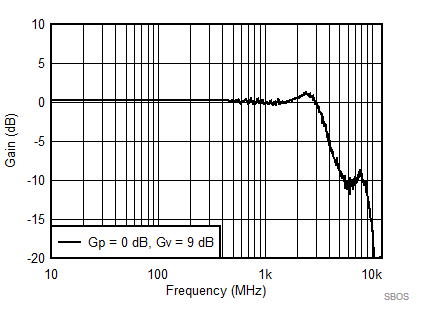ZHCSH86B December 2017 – February 2019 LMH5401-SP
PRODUCTION DATA.
- 1 特性
- 2 应用
- 3 说明
- 4 修订历史记录
- 5 说明 (续)
- 6 Pin Configuration and Functions
- 7 Specifications
-
8 Parameter Measurement Information
- 8.1 Output Reference Nodes and Gain Nomenclature
- 8.2 ATE Testing and DC Measurements
- 8.3 Frequency Response
- 8.4 S-Parameters
- 8.5 Frequency Response with Capacitive Load
- 8.6 Distortion
- 8.7 Noise Figure
- 8.8 Pulse Response, Slew Rate, and Overdrive Recovery
- 8.9 Power Down
- 8.10 VCM Frequency Response
- 8.11 Test Schematics
- 9 Detailed Description
-
10Application and Implementation
- 10.1 Application Information
- 10.2
Typical Application
- 10.2.1 Design Requirements
- 10.2.2 Detailed Design Procedure
- 10.2.3 Application Curves
- 10.3 Do's and Don'ts
- 11Power Supply Recommendations
- 12Layout
- 13器件和文档支持
- 14机械、封装和可订购信息
10.1.1 Stability, Noise Gain, and Signal Gain
Two types of gain are associated with amplifiers: noise gain (NG) and signal gain. Noise gain determines the stability of an amplifier. The noise gain is the inverse of the voltage divider from the outputs back to the differential inputs. This gain is calculated by NG = (RF / RIN) + 1. For the LMH5401-SP, NG > 4 creates a stable circuit independent on how the signal gain is set. In Figure 61, for optimal performance choose RF within the values noted in this document (see the section for further information). Using too large of a resistance in the feedback path adds noise and can possibly have a negative affect on bandwidth, depending on the parasitic capacitance of the board; too low of a resistance can load the output, thus affecting distortion performance. When low signal gain stability is needed, the noise gain can be altered with the addition of a resistor, Rcomp. By manipulating the noise gain with this addition, the amplifier can be stabilized at lower signal gains. In Figure 61, RS and Rcomp in parallel combination also affects the noise gain of the amplifier. RG and RF are the main gain-setting resistors and the addition of Rcomp adjusts the noise gain for stability. Much of this stability can be simulated using the LMH5401-SP TINA model, depending on the amplifier configuration. The example in Figure 61 uses the LMH5401-SP, a signal gain of 2.8 V/V, and a noise gain of 4.75 V/V resulting in the frequency response shown in Figure 62.
 Figure 61. Noise Gain Compensation for Stability at Gp = 0 dB
Figure 61. Noise Gain Compensation for Stability at Gp = 0 dB  Figure 62. SE-DE Small Signal Frequency Response for Low Gain
Figure 62. SE-DE Small Signal Frequency Response for Low Gain